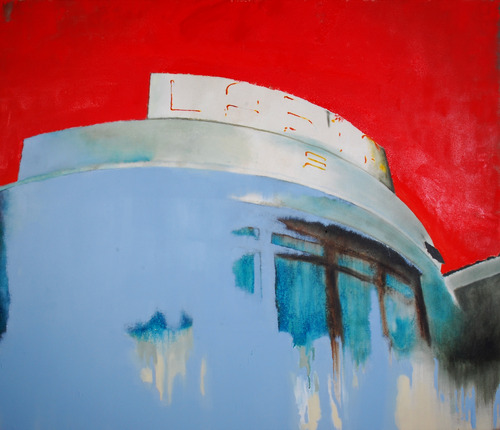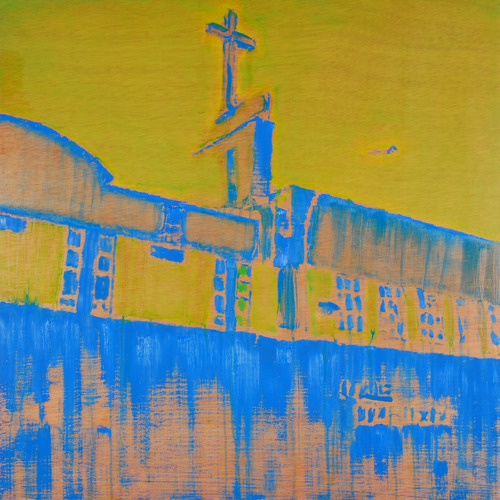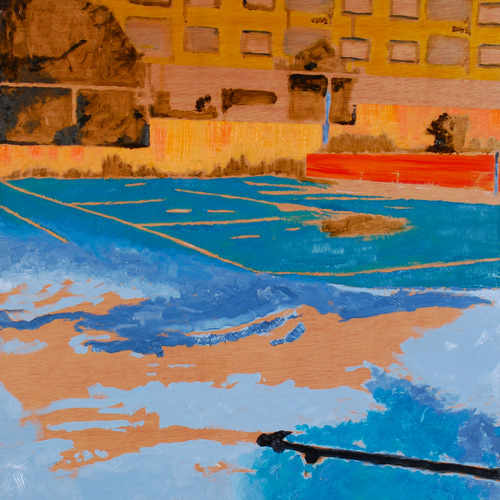Cape Town, I Love You But You’re Letting Me Down
15 November 2010
“The imaginary is that which tends to become real.”
— André Breton, Le Revolver à Cheveux blancs
“The ambiguity is as important as specificity. It becomes a beautiful dialogue, a tightrope walk, between abstraction and representation.”
— Wayne Thiebaud
Spaces function as revelations; they effect our imagination and place us in a state of reverie. They have the ability to evoke, capture and retain the memories and experiences of their occupants. They exert a variety of influences on our senses, affecting among other things our imagination, memory and perceptions. The effect of spaces is so profound that we tend to personify their qualities and compare them to people. Yet the evocations of spaces remain a subjective discussion. Primarily a phenomenological experience having little to do with logically explicable facts, it is not easy to understand how the evocations brought on by certain spaces affect us, and to what purpose. This body of work reflects my engagement with the spaces familiar to me, in a sense trying to understand their familiarity in an urban landscape that is constantly changing. In these surfaces an innocuous fairground sign becomes a progenitor, a desolate basketball court hints at some kind of sadness and the off-coloured wall of a supermarket forms an oneiric horizon.

George Chapman, ‘Untitled II (I Can Never Sleep on Sundays)’ (2010)
The theoretical springboard for most of my practice originated from movements, works and theorists all at their apex during the middle of the twentieth century. At this point in time, the modern world had set its sights on new horizons. Within the same year that witnessed the launch of the first man-made object in space, initiating an era of exploration within an entirely new and potentially limitless expanse, new theories regarding the experience of spaces began to manifest through the establishment of the Situationist International as well as in the writings of the Sorbonne philosopher Gaston Bachelard. The excitement of travel was epitomised in Jack Kerouac’s novel On the Road, Kerouac’s seminal account of his experiences exploring the vast open stretches of the American highway. During this time Abstract Expressionism had already reached its apogee in illustrating Clement Greenberg’s notion of formalism: the celebration of the two-dimensional medium and removal of “the space that recognisable objects could inhabit.” (Berman 2010:22). Three years later Yves Klein’s Leap into the Void would pre-empt Yuri Gagarin by six months. The representation of space as we understood it had changed drastically. It was without doubt a daydream epoch for the oneiric imagination; our experiences may only have seemed limited to the extent of these new latent horizons.
I was influenced by the Situationist idea of the dérive in obtaining my source material: random ‘drifts’ through ambient spaces, documented through photography and later altered by reducing the images in terms of colour and form to effectively capture the evocations I experienced of spaces.This process provided me with a wealth of information that I gradually began to sift through by translating them to canvas. The Situationist theories of Guy Debord and Asger Jorn became increasingly relevant to my work, not only in terms of the individual’s engagement with an urban geography but also with regards to the ‘construction’ of ambiences and ‘situations’, and how these could potentially lead to a new understanding and experience of these spaces. The Situationist International was established as a revolutionary collective hoping to combat, among other issues, what Debord called “a state of decomposition”. Similar to how the Abstract Expressionists sought the transcendental metaphysical realm to replace the atrocities and antagonisms of their post-war reality Debord argued that “one must seek a higher organisation of the means of action in this period of our culture.” (Debord, 1997: 85).

George Chapman, ‘Untitled XII (I Can Never Sleep on Sundays)’ (2010)
However, the Situationists did not look to art as the medium to achieve their “higher organisation”. Instead the medium would be their ability to create environmental ambiences: “Our central idea is the construction of situations… the concrete construction of momentary ambiences of life and their transformation into a superior passional quality.” (Knabb, 2006: 38). The French socialist and geographer Elisée Reclus argued that space was the product of social behaviour, possessing the ability to reproduce social relations (McDonough, 1994: 66). The construction of situations relied on two factors: the environment and the knowledge of its effects on the occupants, dubbed ‘psychogeography’. The Situationists theorised that through the successful transformation of the environment into a space that is conducive to the construction of situations, the participating proletariat would become stimulated and in turn produce new and more advanced forms of culture. The Situationists sought to differentiate from the objective aesthetic notions of movements such as Abstract Expressionism, which championed that the artwork was the embodiment of an eternal truth or reality (an idea viewed by the Situationists as yet another manifestation of ‘the spectacle’). I was also interested in how the Situationists rejected the notion of nostalgia: more often than not we tend to reduce our experiences of places into sentimental memories. The ambiences sought by the Situationists were not those of sentimentality but of poetic experience, and were intended to be celebrated along with the present while resisting the psychological culture of permanence or nostalgia: “The entire socioeconomic structure tends to make the past dominate the present, to freeze living persons, to reify them as commodities… The taste for false novelty reflects its unhappy nostalgia” (Knabb, 2006: 80), further adding: “Eternity is the grossest idea a person can conceive of in connection with his acts.” (Knabb, 2006: 41). Gaston Bachelard reiterated this sentiment, stating: “It is better to live in a state of impermanence than in one of finality.” (Bachelard, 1994: 61). Through the successful creation and implementation of the group’s strategies, the Situationists had hoped to multiply the poetic qualities of space resulting in an enrichment of meaningful experiences not cheapened by spectacular reproductions (Knabb, 2006: 41).
The theories of Gaston Bachelard became a relevant step forward once I had become interested in the subjective experience of space. Bachelard’s phenomenological writings on the imagination and reverie have led academics of numerous fields including art, aesthetics, architecture and science to reconsider ideas of consciousness and cognitive experience. The Poetics of Space, originally published in 1957, focuses on the effects of spaces with regard to the imagination. His phenomenological approach allows his readers to follow these subjective experiences offered by the home. Rather than methodically attempt to explain the effects of intimate spaces in an analytical manner Bachelard’s observations are instead substantiated by quotes of Romantic era poets such as Charles Baudelair, Rainer Maria Rilke and Jules Superveille. Rilke’s work, in particular, becomes highly relevant in its struggle to communicate with the ineffable. In the text Bachelard distinguishes between what he calls the formal and material imagination: “The formal axis draws its impetus from the novel, the varied, and the unexpected; the material axis roots itself in the primitive and the eternal.” He asserts the material imagination over the formal since it receives our immediate and intimate contact with images (in other words, our perceptions) later conceptualised by the formal imagination (Picart, 1997: 64).
Concerning these conceptualisations of the formal imagination Edward Kaplan notes: “Traditionally imagination is thought of as the faculty of forming images. For Bachelard, however, imagination ‘is rather the faculty of deforming images provided by perception; it is above all the faculty of liberating us from the first images [here representations in perception], of changing images’.” (Kaplan, 1972: 2). That said, the aesthetic value Bachelard’s examination of effects on the imagination becomes clear: it links the perceptual with the conceptual through the transformation of images. Mnemonic and nostalgic images are encoded in the language of spaces, requiring the imagination to activate the experiences of the familiar. Memory, like the vague celluloid imagery of micro-film, requires the external light of our imagination to re-illuminate the scenery (Bachelard, 1994: 175). Bachelard also notes that “imagination, memory and perception exchange functions,” (Bachelard 1994: 59) mediated in the subject of this work through spatial experience. The value of abstraction is also noted as being fundamental to the existence of certain images: “Such images as these must be taken, at the least, in their existence as a reality of expression. For they owe their being to poetic expression, and this being would be diminished if we tried to refer them to a reality.” (Bachelard, 1994: 177). Thus it is necessary for these images to exist in a non-literal reality if they are to retain the most significance. This thought reiterates itself in the work of Abstract Expressionism, and would formally influence my practice once I had realised that the idea of ambiguity, of representation versus non-representation, was a useful way of communicating the effects of my locations.

George Chapman, ‘Untitled XV (I Can Never Sleep on Sundays)’ (2010)
Abstraction has often been attributed the ability to extract highly personalised reactions from its audiences: Robert Rosenblum recounted a stranger’s “religious experience” of Clyfford Still’s seventy-two canvases in his 1961 article, ‘The Abstract Sublime’ (Rosenblum, 1999: 72). Kandinsky spoke of his subjective experience of painting in his 1913 autobiography Rückblicke, indicating that he “experienced objects, events, even music primarily in terms of color, and did not conceive of colour in its physical and material aspects but rather in its emotional effect.” (Selz 1957: 128). In conversation with the poet and critic Selden Rodman, Mark Rothko pointed to the reactions his paintings solicited from their viewers: “…the fact that lots of people break down and cry when confronted with my pictures shows that I communicate those basic human emotions. The people who weep before by pictures are having the same religious experience I had when I painted them.” (Rothko, 2006: 119–120). From its antecedents it became clear to me that abstraction has in its allusions of the ineffable sublime and metaphysical representations provoked successful (and often intentional) responses from its audiences, asserting the validity of the non-objective form over that of realism and direct representation. Formally my concerns lie between the fields of figuration and abstraction. While researching my subjects I realised that the viewer could obtain a more subjective and nostalgic interpretation if the scenes I chose to portray were not painted with the kind of objective realism most commonly associated with the genre of landscape painting. As I noted before, spaces also function as revelations. They ‘reveal’ experiences, memories and ambiences to us in ways that are difficult to concisely describe. During the era of Abstract Expressionism, artists, critics and audiences alike appear to have been entirely convinced by this mode of representation, of transcendental reality as an otherly experience of space. This is no more evident than in Rosenblum’s quote of Thomas Moore, recounting his experience of Niagra Falls, quoted to illustrate the effect of the abstract transcendental:
“I felt as if approaching the very residence of the Deity; the tears start into my eyes; and I remained, for moments after we had lost sight of the scene, in that delicious absorption which pious enthusiasm alone can produce… Here all its awful sublimities rushed full upon me… My whole heart and soul ascended towards the Divinity in a swell of devout admiration, which I never before experienced.” (Rosenblum, 1999: 72-3)
Through these texts I concluded that the phenomenological nature of memory and nostalgia induced by spaces is a poetic experience, and should thus be translated into poetic expression via the image. By this I mean the ambiguity of abstract and representational form, which allows the viewer to read enough into the ‘revelatory’ aspects of what they recognise in the image while referring to their own experience of the landscape through non-specificity, or abstraction of colour and form. However, when I look at my own work, I get no sense of divinity or spiritual satisfaction, but only a relentless bathos that reminds me of the situations and locations from which the images arose.
(Adapted from my honours thesis for the ‘I Can Never Sleep on Sundays’ exhibition catalogue, November 2010)
Bibliography
Bachelard, G. 1994. The poetics of space. Translated from French by M. Jolas. Boston: Beacon Press
Berman, E. 2010. All art has a history. Art South Africa. 8(3): 22-23
Debord, G. 1997. One more try if you want to be Situationists (The S.I. in and against decomposition). October. 97: 85-89
Kaplan, E.K. 1972. Gaston Bachelard’s philosophy of the imagination: an introduction. Philosophy and Phenomenological Research. 33(1): 1-24
Knabb, K. Ed. 2006. Situationist International anthology. Translated from French by K. Knabb. 4th ed. Berkeley: Bureau of Public Secrets
McDonough, T.F. 1997. Rereading Debord, rereading the Situationists. October. 79: 3-14
Picart, C.J.S. 1997. Metaphysics in Gaston Bachelard’s “Reverie”. Human Studies. 20(1): 59-73
Selz, P. 1957. The aesthetic theories of Wassily Kandinsky and their relationship to the origin of non-objective painting. The Art Bulletin. 39(2): 127-136
Rosenblum, R. 1999. On modern American art: selected essays by Robert Rosenblum. New York: Harry N. Abrams
Rothko, M. 2006. Writings on art. Edited by M. López-Remiro. New Haven: Yale University Press
—